The Clockwork Rocket Read online
Page 6
“Exactly,” Yalda said.
Eusebio understood these calculations well enough, but he was less happy with the bigger picture. “Energy is where the ‘conservation laws’ start to sound more like a long list of exceptions,” he complained.
“Maybe. Tell me about the exceptions.”
“Gravity! Drop a book from my window; its kinetic energy certainly won’t stay the same. And the fact that the book pulls the world up toward it with as much force as the world pulls it down doesn’t help; that keeps momentum balanced, but not kinetic energy.”
“Sure.” Yalda brought one of the diagrams she’d rehearsed onto her chest.
“If you plot the downward force on the book against its height above the ground,” she said, “it’s a constant, a flat, straight line. Now think about the area under that line, up to the point representing the book’s current height. When the book falls, the reduction in the area—the little rectangle that gets chopped off—will equal the force on the book times the distance it travels—which is precisely the amount by which its kinetic energy increases: force times distance.”
Eusebio examined the diagram. “All right.”
“Alternatively, if the book is tossed upward and gravity starts to slow its fall, it will be losing kinetic energy… but the area under the line will increase in a way that precisely balances the loss. So, we call this area ‘potential energy’, and the sum of the two kinds of energy, kinetic and potential, will be conserved.
“This works for other simple forces, too—like the force on an object attached to a stretched spring.”
Eusebio said, “I understand why the mathematics works out as you’ve described it. But isn’t this just a fancy way of saying: kinetic energy isn’t conserved, it changes… and in a few simple cases we understand the forces responsible, well enough to be able to keep track of the changes?”
“Well, yes,” Yalda agreed. “It’s a kind of accounting. But don’t disparage accounting; it can be a powerful tool. Elastic potential energy can tell you how fast a projectile will fly out of a slingshot; gravitational potential energy can tell you how high that projectile will rise.”
Eusebio wasn’t persuaded. He gestured at his marching figurines; two of them had wound down and come to a halt, while the third had ended up on its back, kicking its legs ineffectually. “In the real world, energy isn’t conserved,” he said. “It comes out of food, or burning fuel, and it vanishes as friction.”
“That might sound like the best explanation,” Yalda said, “but those processes are just more complex examples of the very things we’ve been discussing. Friction turns motion into thermal energy, which is the kinetic energy of the constituents of matter. And chemical energy is believed to be a form of potential energy.”
“I understand that heat is a kind of invisible motion,” Eusebio said, “but how does burning fuel fit into this scheme?”
Yalda said, “The way to make sense of a particle of fuel is to imagine a ball of springs all knotted together tightly, then tied up with string. The action of the liberator is like cutting the string: the whole thing flies apart. But instead of a tearing sound and springs flying everywhere, from fuel you get light and hot gas.”
Eusebio was bemused. “That’s a charming image, but I don’t see how it helps in any practical way.”
“Ah, but it does!” Yalda insisted. “By reacting various chemicals together in sealed vessels—which trap all the products, and turn all the light into heat—people have built up tables showing how much potential energy different substances have, relative to each other. Fuel and liberator are like something on the tenth floor of this tower, while the gases they produce are on the ground floor. The difference in chemical energy manifests itself as pressure and heat, just as the difference in gravitational energy, if you dropped a book from that height, would manifest itself in the book’s velocity.”
Eusebio was growing interested now. “And it all works out? Chemical energy is like a kind of accounting, it’s as simple as that?”
Yalda realized that she might have oversold the idea, just slightly. “In principle it should work, but in practice it’s hard to get accurate data. Think of it as a work in progress. But if you ever go out to the chemistry department—”
Eusebio buzzed amusement. “I’m not suicidal!”
“You can always watch their experiments from behind the safety walls.”
“You mean the ‘safety walls’ that need to be rebuilt three or four times a year?”
The truth was, Yalda had only visited Amputation Alley once herself. She said, “All right… be content to reap the benefits from a distance.”
“You say it’s a work in progress,” Eusebio mused. “Fatal explosions aside, what’s the hitch?”
“I’m no expert in their methodology,” Yalda admitted. “I suppose there’s room for errors to creep in when they measure temperature and pressure, and I expect it’s also hard to trap all the light. We can measure the energy in heat, but if there’s light emitted we don’t know how to account for that.”
“So how exactly do you know that they’ve made mistakes?” Eusebio pressed her. “What is it that tells you that their data is wrong?”
“Ah.” Yalda hated to disillusion him, but she had to be honest about the magnitude of the problem. “Someone showed that the values in the last table they published could be used, indirectly, to derive the result that pure, powdered firestone and its liberator contained only slightly more chemical energy than the gases they produce—nowhere near enough to explain the high temperature of the gases. But that extra thermal energy can’t just fall out of the sky; it has to come from a change in chemical energy. And that’s before you even start worrying about the energy carried off by the light.”
“I see,” Eusebio announced cynically. “So ‘chemical energy’ is a beautiful theory… but after all that risk and toil, the results show that it’s actually nonsense?”
Yalda preferred a different interpretation. “Suppose I told you that a friend of a friend of mine had seen a pebble drop from a third floor window, but you knew that the pebble in question had hit the ground with a deafening crash, and made a crater two strides deep. Would you throw out the whole idea of conservation of energy… or would you doubt my third-hand account of the height from which the pebble had fallen?”
Yalda squeezed into the lecture theater just as the guest speaker, Nereo, began ascending to the stage. There were only about four dozen people in the audience, but the venue had been chosen for its facilities, not its capacity, and the optics classes that were given here usually attracted just a couple of dozen students. Her late entry brought some resentful glares, but at least her height gave her the advantage of not needing to jostle for position—and when she realized that she was blocking the view of the young man behind her, she quickly changed places with him.
“My thanks to the scientists of Zeugma for their generous invitation to speak here today,” Nereo began. “I am delighted to have this opportunity to discuss my recent work.” Nereo lived in Red Towers, where his research was supported by a wealthy patron. With no university there, he had no colleagues around him to challenge or encourage him, though perhaps the whims of a rich industrialist were less onerous to deal with than Zeugma’s academic politics.
“I am confident,” Nereo continued, “that this learned audience is intimately familiar with the competing doctrines regarding the nature of light, so I will not spend time recapitulating their strengths and weaknesses. The wave doctrine rose to favor over the particle doctrine more than a year ago, when our colleague Giorgio showed that two narrow slits in an opaque barrier, illuminated with light of a single color, cast a pattern of alternating bright and dark regions—as if waves emerging from the two slits were slipping in and out of agreement with each other. The geometry of this pattern provided a means of estimating the light’s wavelength—and the measurements suggested a wavelength for red light about twice that for violet.”
Yalda
looked around for Giorgio, her supervisor; he was standing near the front of the audience. She’d found his experiments persuasive, though many long-time proponents of the particle doctrine were unmoved. Why invoke some fanciful notion of “wavelength”, they argued, when every child who’d ever glanced up at the stars could see that what distinguished one color of light from another was simply its speed of travel?
“With all respect to my colleague, though,” Nereo said, “the double-slit pattern has often proved difficult to work with. The pattern is faint and the features that we wish to locate precisely can be indistinct, leading to considerable uncertainty in the measurements. In the hope of remedying these problems, I have investigated a natural extension of Giorgio’s idea.
“Suppose we obtained a large number of identical sources of any vibration, and arranged them in a line in a regular fashion, with a spacing roughly comparable to, but exceeding, the wavelength of the vibration itself.”
An image appeared on Nereo’s chest.
“If we ask in what direction the wavefronts from all these sources will come into agreement,” he said, “the answer is that, firstly, they will agree if you move orthogonally away from the line on which they lie. However, that’s not the only case. They will also agree at another angle, at a particular inclination to the central direction on either side.”
“Unlike the first direction, though, this one will depend on the wavelength of the vibration: as the wavelength grows, the angle from the center grows too.”
“The precise relationship between wavelength and angle is a simple trigonometric formula that will be familiar to all of you from Giorgio’s work; he dealt with two sources, and I am merely extending that idea. But increasing the number of sources does yield a powerful advantage: the passage of more light delivers a brighter, clearer pattern.”
Nereo gestured to an assistant, who pulled on a control rod for the blinds covering the skylight, plunging the theater into darkness. Before Yalda’s eyes had time to adjust, three brilliant patches of light appeared on a screen behind the now-invisible speaker. She recognized the central one as an almost unmodified image of the sun, captured by the heliostat on the theater’s roof. On either side of it were two dazzling streaks of color, distorted echoes of the primary image. Their inner rims, closest to the center of the screen, were deep violet, and they progressed in a rich, clear spectrum all the way to red. They were like star trails for the sun.
Nereo spoke from the darkness. “With the aid of my benefactor’s best machinists, I constructed a system of pantographs to etch precisely-spaced apertures in a sliver of calmstone: more than two dozen gross per scant. My measurements imply that vibrations of violet light come six dozen gross to the scant; the reddest light about three and a half dozen.” This was broadly in agreement with Giorgio’s results: a refinement, not a contradiction.
Yalda had seen a similar spectacle produced many times before, with clearstone prisms, but beyond the sheer beauty of Nereo’s crisper version she understood its significance. No one could give a detailed account of the underlying process by which a prism split light into its individual colors, so the angles at which different hues emerged from the slab of clearstone revealed nothing about the light itself. But Nereo’s barrier was not mysterious; every aperture’s location was known to him, every microscopic detail was there by his design. That light could be a vibration at all defied common sense—what was there to vibrate, in the void between the stars?—yet here was not only compelling evidence for that doctrine, but also a clear, unambiguous way to attach a wavelength to every hue.
The blinds were opened again. Yalda barely listened to the audience’s questions; the only thing she wanted to ask Nereo was how soon he could make another of these marvels. While Ludovico droned on about the “obvious” possibilities for reconciling Nereo’s experiment with the doctrine of luminous corpuscles, Yalda fantasized about pantographs. If Nereo could not supply them with a light comb, perhaps the university could make its own?
When the session ended, she moved quickly to the front of the theater; as one of Giorgio’s students it was her responsibility to help provide hospitality to his guest. Rufino and Zosimo were already hovering nearby, ready to escort Nereo to the food hall. But as the two great experimentalists chatted, Nereo’s rear gaze fell on Yalda. Her size made it hard for anyone to ignore her, and when their eyes met she seized the opportunity.
“Excuse me, sir, but I neglected to ask a question of you earlier,” she said.
Giorgio did not look pleased, but Nereo indulged her. “Go ahead.”
“The position of light within a star trail depends on its velocity,” she began. “If you fed successive slices from a star trail through your device, might that not allow you to build up a detailed picture of how the wavelength and velocity are related?” When Nereo did not reply straight away, Yalda added helpfully, “The university has an excellent observatory on Mount Peerless. A collaboration, combining the two instruments—”
Nereo cut her off. “If you took a sliver of a star trail narrow enough to characterize the light’s velocity, it would not make a bright enough source. The diffracted image with the wavelength information would be so dim as to be invisible.”
He turned back to Giorgio. Yalda cursed herself silently; she hadn’t thought through the practicalities.
As the five of them left the lecture theater and crossed the cobbled grounds, she struggled to find a way to salvage her proposal. The chemists were forever promising to devise a light-sensitive coating for paper that could record a telescopic image of the stars if subjected to a sufficiently long exposure. But their best offerings to date only responded to a narrow band of colors, and were prone to spontaneous combustion.
When they reached the food hall, Ludovico was waiting just inside the entrance. Zosimo bravely split off and approached him, improvising some diversionary nonsense about an administrative issue with his fees. Everyone welcomed debate about the merits of the wave and corpuscular doctrines, but Ludovico had crossed the line into monomania.
Yalda and Rufino went to fetch food from the pantry. “You must have sensitive eyes, Yalda,” Rufino teased her, “to aspire to measure the wavelength of a wisp of starlight.”
“There must be a way,” she retorted, extruding an extra pair of arms to deal with the choice of six seasoned loaves it was customary in Zeugma to offer to a guest.
The food hall wasn’t crowded; most people took lunch later, at the third bell. As Nereo and Giorgio sat eating, Yalda and Rufino stood by attentively; Zosimo was nowhere to be seen, but he must have stuck to his story and goaded Ludovico, as the department’s treasurer, into dragging him back to his office to check the payment records.
Contemplating the effort and skill that must have gone into the construction of Nereo’s marvel, Yalda realized that it would take the university years to develop the facilities to make their own light combs; the precision required was far beyond their present capabilities. If Nereo departed without an agreement to collaborate with them, they’d be left with nothing but the tables he’d doubtless publish in due course, assigning wavelengths to various subjectively judged hues. Being told how many vibrations of “red”, “yellow” or “green” light there were to a scant wasn’t utterly useless, but compared to being able to quantify the wavelength of an actual beam of light on an optical workbench it was a miserable second best. And to have any hope at all of making sense of light, they needed good numbers. Mathematics had been used to understand the vibrations of sound, the vibrations of solids, the vibrations of plucked strings—linking the properties of those diverse kinds of wave with the properties of the media that supported them. The medium that supported light was the most elusive of all, but if they could wrap the waves themselves in numbers, even this strange substance might yet be brought into the realm of comprehension.
Nereo stood and addressed the students. “The food was delicious; thank you.”
Desperate, Yalda blurted out an idea that had bee
n lurking unvoiced in the back of her mind. “Sir, forgive me, but… what if you fed an entire star trail into your device? Properly focused, wouldn’t the spread of colors be recombined into an image that was bright enough to see?”
Giorgio said, “Please! Our guest is tired!”
Nereo raised a hand, requesting his forbearance, and responded to Yalda. “By the principle of reversibility, yes—but only if the way the colors were distributed by the two methods were in precise agreement, which I doubt would be the case.”
Yalda’s skin tingled with excitement. If the recombination of the colors was sensitive to the detailed way the light was brought together, all the better.
“What if the star trail was focused by means of a flexible mirror?” she suggested. “A band that could be adjusted to vary the angles at which the colors were delivered, all along its length. By changing the shape of that mirror until the combined system yielded a single, sharp image for the star… wouldn’t the final, successful shape embody information about the relationship between wavelength and velocity?”
Nereo fell into a thoughtful silence. Rufino stared at the floor, embarrassed. Giorgio stared directly at Yalda; she could tell that he was actually quite taken by the sheer audacity of her suggestion, if not by the clumsy way she’d raised it.
Nereo said, “It just might work. And if you blocked the center of the star’s image—the brightest part—your eyes would adapt to the lesser brightness of the remaining halo, allowing you more easily to judge when your adjustments had diminished it as much as possible.”

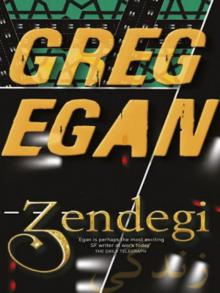 Zendegi
Zendegi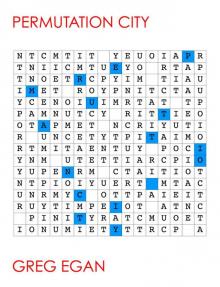 Permutation City
Permutation City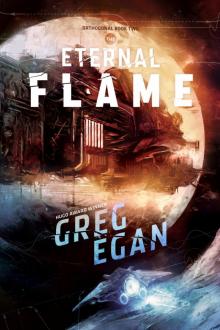 The Eternal Flame
The Eternal Flame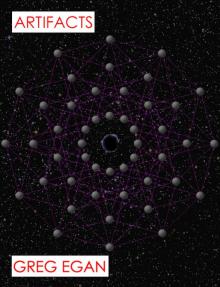 Artifacts
Artifacts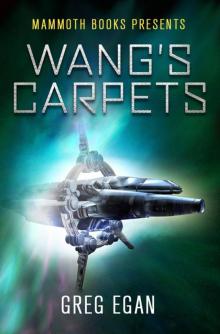 Wang's Carpets
Wang's Carpets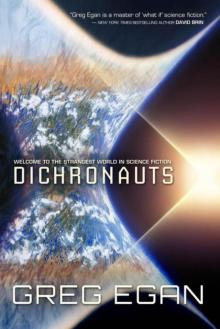 Dichronauts
Dichronauts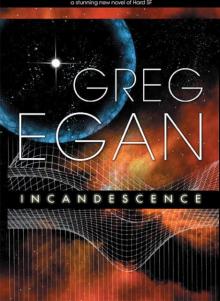 Incandescence
Incandescence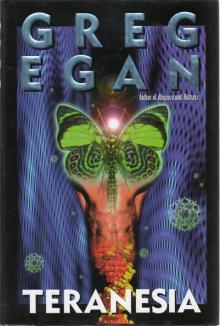 Teranesia
Teranesia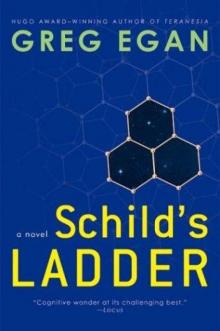 Schild's Ladder
Schild's Ladder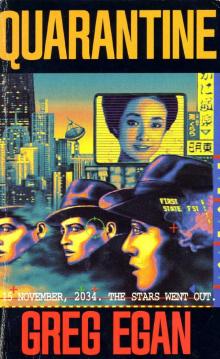 Quarantine
Quarantine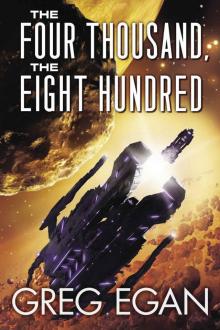 The Four Thousand, the Eight Hundred
The Four Thousand, the Eight Hundred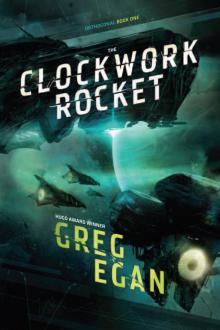 The Clockwork Rocket
The Clockwork Rocket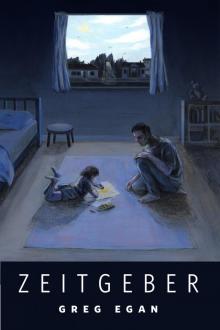 Zeitgeber
Zeitgeber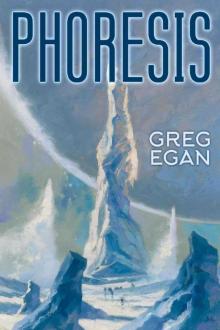 Phoresis
Phoresis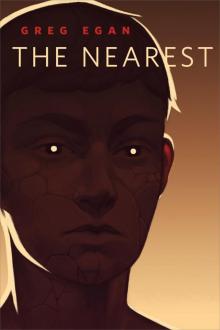 The Nearest
The Nearest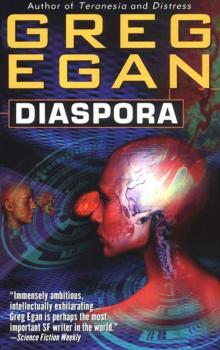 Diaspora
Diaspora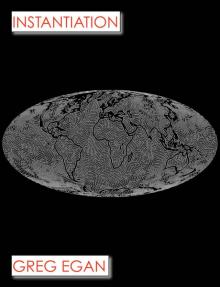 Instantiation
Instantiation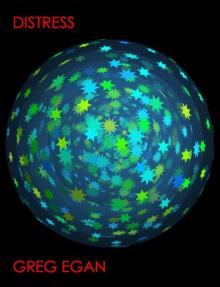 Distress
Distress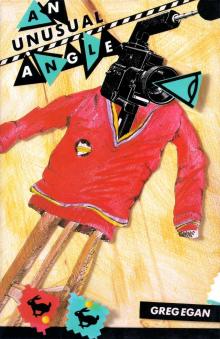 An Unusual Angle
An Unusual Angle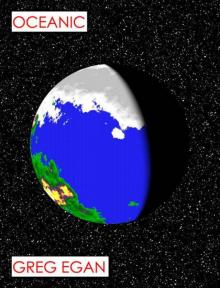 Oceanic
Oceanic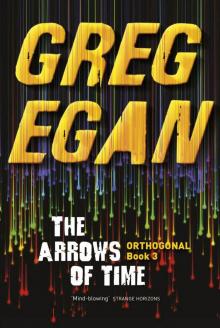 The Arrows of Time
The Arrows of Time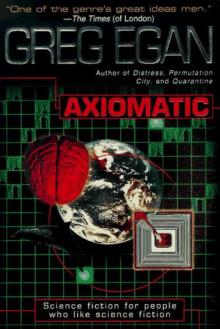 Axiomatic
Axiomatic![Anthology 2. Luminous [1998, 2010] Read online](http://i1.bookreadfree.com/i/03/18/anthology_2_luminous_1998_2010_preview.jpg) Anthology 2. Luminous [1998, 2010]
Anthology 2. Luminous [1998, 2010]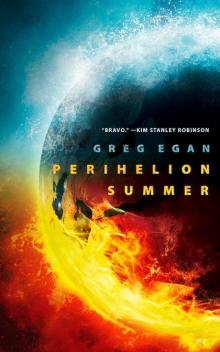 Perihelion Summer
Perihelion Summer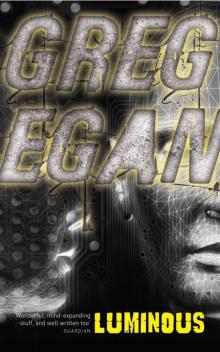 Luminous
Luminous